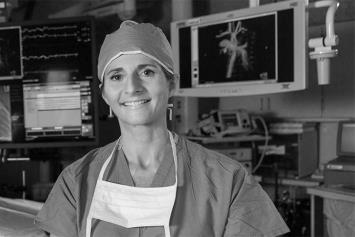Rhabdomyosarcoma
Rhabdomyosarcoma is a rare type of cancer that starts in the muscles.
What Is Rhabdomyosarcoma?
Rhabdomyosarcoma (rab-doe-my-oh-sar-KOE-mah), or RMS, is a soft-tissue cancer. It can start in muscle cells (rhabdomyoblasts) from many different areas of the body. The cancer (sarcoma) grows in soft tissue such as muscle, connective tissue (like tendons or cartilage), blood vessels, nerves, and joint membrane tissue.
Soft tissue cancer is rare in infants and children. RMS, which is the most common type of this cancer diagnosed in children, accounts for more than half of these cancers.
There are two common types of RMS:
-
Embryonal RMS is the most common type of RMS. It most often occurs in the head and neck area, or in the genital area.
-
Alveolar RMS most often occurs in the arms, legs, or trunk (chest and abdomen). This type occurs more often during the teen years.
What Are the Signs and Symptoms of Rhabdomyosarcoma?
Signs and symptoms of this kind of tumor depend on its location. Most RMS starts out as a lump or swelling that keeps getting bigger and does not go away. Some children may have unusual bleeding.
The most common sites are:
-
Head and neck: the tumor may start inside the nose or sinuses. It may cause a blocked nose or nasal discharge. It may stick out from the ear or nose. There may be ear drainage, headache, facial pain, a lump in the neck, or signs of sinusitis. Areas of the face may become weak.
-
Eye socket or orbit: the tumor may cause the eye to bulge or to be pushed downward. It may also cause vision changes.
-
Trunk of the body: if the tumor is in the abdomen (belly), it may cause constipation, painful bowel movements, bloody urine, difficulty urinating, or swelling of the groin area.
-
Muscles of arms or legs: the tumor may feel like a lump or a mass, and may be painful.
-
Other areas of the body: tumor cells may also spread to other parts of the body. Common areas are the lungs, liver, brain, bones and bone marrow.
How Is Rhabdomyosarcoma Diagnosed?
You might notice a swelling or lump at home, or your child’s doctor may see or feel a lump during a check-up. The following tests or procedures may be used by the doctor to diagnose RMS:
-
X-ray: an X-ray looks at the organs & bones inside the body.
-
CT scan (Computerized Tomography scan): a CT scan (also called a cat scan) takes a series of detailed pictures. It shows areas inside your child’s body, taken from different angles. A dye may be injected into a vein or swallowed to help the organs and tissues show up more clearly.
-
MRI (Magnetic Resonance Imaging): an MRI uses a magnet, radio waves, and a computer to make a series of detailed pictures of areas inside the body.
-
PET scan: a PET scan may be done to find out whether the tumor has spread to any other areas of the body. PET can also be used to find out how active the tumor cells are, and may help doctors choose treatment responses.
-
Biopsy: a tumor biopsy is needed to make a diagnosis and find out what treatment is needed. This is done under anesthesia. It is usually done in the operating room through an incision made by the surgeon while the child is still asleep.
-
Bone marrow aspiration and biopsy: bone marrow aspiration and biopsy are necessary to see if the tumor has spread to the bone marrow. This test is done under anesthesia. It is usually done in the operating room while the child is still asleep.
-
Additional testing may be needed, depending on the location of the tumor.
Staging
Staging helps your child’s health care team to decide the type of anti-cancer drug, dose, and the number of treatments the child will need.
RMS is usually given a stage number (I, II, III, or IV) depending on:
-
Size of tumor
-
Location of tumor
-
Type of tumor
-
Number of areas with tumors or if it has spread
-
How much was removed with surgery
-
Chance of tumors coming back (the risk group)
How Is Rhabdomyosarcoma Treated?
RMS is treated with a combination of surgery, chemotherapy, and sometimes radiation therapy. Treatment options for RMS are decided by the risk group category: low risk, intermediate risk, and high risk. Before therapy begins, your child’s treatment team will discuss with you in detail the child’s risk group and what treatments they recommend.
If you have any questions or concerns, be sure to talk with your child’s doctor or nurse.
Helping Hands Patient Education Materials
Written and illustrated by medical, nursing and allied health professionals at Nationwide Children's Hospital, Helping Hand instructions are intended as a supplement to verbal instructions provided by a medical professional. The information is periodically reviewed and revised to reflect our current practice. However, Nationwide Children's Hospital is not responsible for any consequences resulting from the use or misuse of the information in the Helping Hands.
HH-I-132 | ©1990, revised 9/15, Nationwide Children’s Hospital



